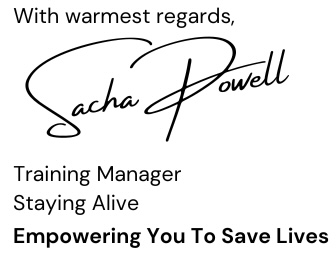A Comprehensive Guide to treating Adults, Children, and Babies for Choking
Introduction:
Choking is a distressing and potentially life-threatening situation that can occur at any age. Knowing how to respond promptly and effectively can make a significant difference in saving a person's life. In this blog post, we will provide a comprehensive guide on first aid choking treatment for adults, children, and babies in the UK, equipping you with the knowledge to act confidently during such emergencies.
Treating an Adult or Child over 1 year for Choking:
- Confirm choking: Ask the person if they are choking. If they can cough, speak, or breathe, it indicates mild choking, in this situation encourage them to cough, ensuring they are leant forward to enable gravity to help the situation and monitor; if the coughing doesn’t work or they’re unable to cough, speak or breathe, it’s a sign they’re choking severely. If this is the case, follow these steps:
- Call for emergency help: Call 999 immediately using the loudspeaker on your phone or ask someone to do this for you, an ambulance can be cancelled if you have success in treating the person choking, but if the object cannot be dislodged or the person becomes unconscious, you have the reassurance that help is already coming.
- Back blows: Stand behind the adult/child (for smaller children, you may need to lay them over your lap) and deliver up to five sharp back blows between the shoulder blades using the heel of your hand, checking after each one to see if the object has been dislodged.
- Perform abdominal thrusts: If after the 5 back blows the person is still choking, stand behind them and place your fist just below the ‘V’ of their ribs. Grasp your fist with the other hand and perform 5 inward and upward thrusts into the abdomen, again, checking after each one. If the abdominal thrusts do not work, go back to step 3, repeat steps 3 & 4 as necessary.
- If the object doesn’t come out and the person loses consciousness and is not breathing, start CPR.
Treating a Baby under 1 year for Choking:
On recognising that a baby is choking follow the steps below:
- Call for emergency help: Call 999 immediately or ask someone to do it for you. Use your mobile on loudspeaker mode to phone 999, if having to make the call yourself.
- Support the baby's head and neck: Place the baby face down along your forearm, with their head lower than their bottom. Use your hand to support their head and neck with the your arm supported by your legs.
- Back blows: Deliver up to five sharp back blows between the baby's shoulder blades using the heel of your hand, check between each back blow, to see if the object has come out.
- Chest thrusts: If needed, perform up to five chest thrusts by using two fingers to press hard and fast between the baby's nipples, again, checking after each chest thrust for signs of the object being cleared. If the chest thrusts do not work, go back to step 3, repeat steps 3 & 4 as necessary.
- If the object doesn’t come out and the baby loses consciousness and is not breathing, start CPR.
Conclusion:
Choking incidents can occur suddenly and pose a severe risk to the affected individual. By understanding the appropriate first aid techniques for treating choking in adults, children, and babies, you can be prepared to respond effectively in such emergencies. Remember to stay calm, encourage coughing, call for emergency help and perform the relevant techniques. By acting swiftly and confidently, you can potentially save a life.
